I have been, or can be if you click on a link and make a purchase, compensated via a cash payment, gift, or something else of value for writing this post. As an Amazon Associate, I earn from qualifying purchases. Please read my full Affiliate Disclosure for more information.
Imagine stepping into a child’s bedroom and feeling an instant burst of inspiration—these spaces are more than just sleep zones; they’re playgrounds for imagination and self-expression. Kid bedroom ideas are incredibly popular because they transform ordinary rooms into vibrant, personalized havens that encourage creativity, learning, and fun. Whether it’s a whimsical theme or a cozy corner for reading, these ideas capture the essence of childhood wonder and growth.
In this article, you’ll discover a variety of creative and practical ideas to elevate any kid’s bedroom—from playful decor and smart storage solutions to inspiring themes that spark imagination. Each idea is designed to help you craft a space that nurtures your child’s personality while making the room both functional and fun. Get ready to find the perfect inspiration to transform your child’s room into a magical retreat they’ll love!
1. Colorful Wall Murals for Imaginative Play

Kids often see their bedroom as a blank canvas, craving a space that sparks their imagination. A dull wall can feel uninspiring and limit their storytelling or creative ideas. Parents want a room that energizes and invites adventure without constant redecorating. The challenge is finding a way to make walls fun and adaptable without breaking the bank.
Imagine a vibrant mural bursting with colors—perhaps a whimsical forest, a bustling cityscape, or a fantasy galaxy. The textures are smooth to the touch but lively visually, with playful characters or scenes that seem to come alive. The mural covers a large wall, transforming the entire room into an imaginative playground. The bold hues and dynamic imagery make every glance feel like a new adventure.
For younger kids, choose murals with cartoon characters or animals, while older children might prefer abstract patterns or inspiring landscapes. Removable decals or wallpaper offer seasonal updates, so the room stays fresh. You can also tailor murals to match room themes like jungle, space, or underwater worlds. Use color schemes that complement existing furniture to keep everything cohesive.
Start by selecting high-quality, peel-and-stick murals or removable wallpaper that suits your child’s interests. Measure wall dimensions carefully before buying. Prepare the wall surface by cleaning and smoothing it out to avoid bubbles. Carefully align the mural from one corner, smoothing out air pockets with a squeegee or credit card. For DIY murals, use stencils or paint for a more personalized touch—just be prepared for some steady hands. Regular maintenance involves gentle cleaning with a damp cloth; avoid harsh chemicals.
Add personal touches by incorporating your child’s favorite colors or characters into the mural design. Consider painting tiny details or accents around the mural to make it truly unique. Frame parts of the mural with decorative borders or add glow-in-the-dark elements for nighttime adventures. Encourage your kid to participate in selecting or even creating parts of the mural to boost ownership and pride.
Colorful murals turn a plain room into a magical space that nurtures creativity. Your child will love having a room that feels like their own storybook. Plus, it’s a fun project for you too—who knew decorating could be this playful? Ready to unleash the artist in your kid and inspire endless imaginative play?
2. Customized Reading Nook with Cozy Pillows
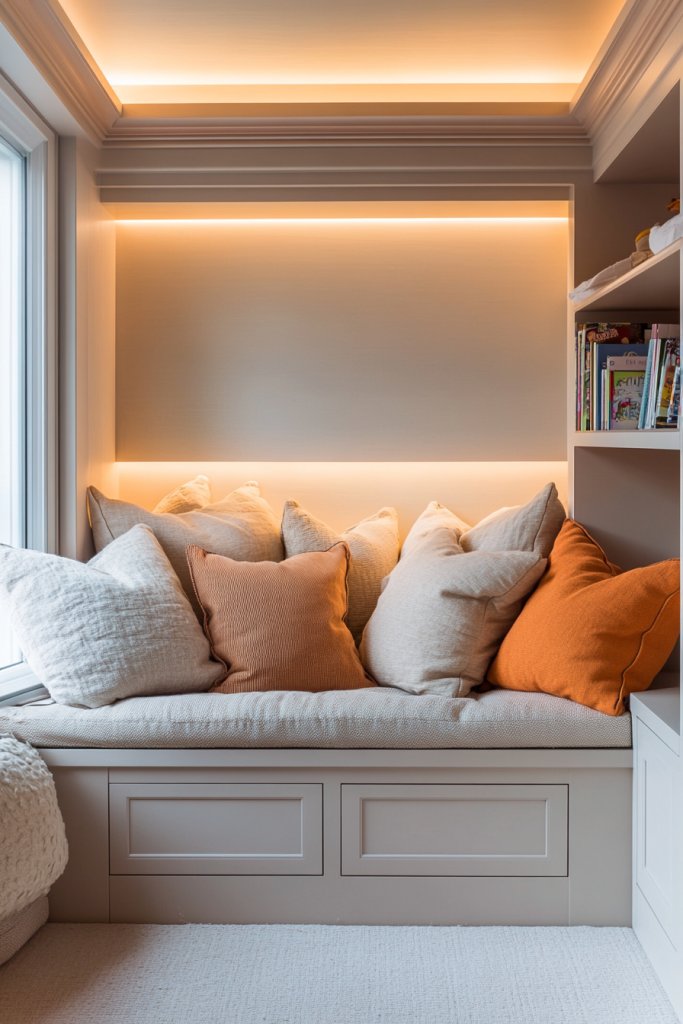
Kids often struggle to find a quiet, inviting spot where they can truly enjoy reading. A generic corner might not feel special enough to encourage daily storytime. Parents want to foster a love for books and learning without turning it into a chore. The trick is creating a cozy, personalized space that beckons them in.
Picture a small nook tucked away in a corner, draped with whimsical curtains that flutter softly when open. Inside, plush cushions and a variety of soft pillows in fun shapes and textures invite kids to sink in for a story marathon. A tiny bookshelf is filled with colorful books, easily accessible for little hands. Soft fairy lights or string lights cast a warm glow, making the space feel magical and safe. The scent of fresh fabric and the gentle feel of plush fabrics make it irresistibly inviting.
For smaller rooms, opt for built-in benches or window seats with storage underneath. Use themed fabrics or patterns that match your child’s interests—pirates, unicorns, or sweet pastel florals. You can add a small, foldable table for snacks or drawing to expand its use. Seasonal updates include swapping pillow covers or curtains for holiday-themed fabrics, keeping the nook fresh and engaging.
Start with a corner that gets good natural light—this makes reading more comfortable. Use soft, washable cushions and pillows that are easy to clean, especially if snacks are involved. Attach a small bookshelf or floating shelves at kid-friendly heights for their favorite books. Hang curtains or fabric panels to create a sense of enclosure and privacy. Incorporate decorative elements like fairy lights or plush rugs for added warmth. Keep it simple but cozy—focus on comfort and accessibility.
Let your child pick out pillow covers, curtains, or small decor items to match their personality. Add a personalized name sign or a framed favorite quote above the nook. Incorporate themed decor, like a pirate flag or fairy banners, to make it unique. Encourage them to help arrange books and pillows to foster a sense of ownership.
A dedicated reading nook turns reading into a delightful adventure rather than a chore. It boosts their confidence in choosing and exploring books independently. Plus, it’s a cozy retreat that they’ll crave after long days. Creating this space shows them you value their interests and learning—what’s better motivation than that?
3. Modular Storage Solutions for Organized Creativity

Cluttered rooms can crush a kid’s creativity and make cleanup time a nightmare. Finding a place for art supplies, toys, and books feels like an endless game of hide-and-seek. Every parent dreams of an organized space that still feels fun and accessible. The challenge is creating storage that adapts as their interests and needs evolve.
Imagine a wall lined with colorful stackable bins and open cubes designed with playful patterns that appeal to kids. A sleek, multi-purpose desk with built-in drawers holds art supplies, while a set of open shelves displays favorite toys and collections. The furniture features rounded edges and bright colors, making the storage inviting yet functional. Transparent containers allow children to see exactly where their treasures are, reducing the ‘lost in the abyss’ moments. It’s a cheerful, organized space that sparks joy and inspiration.
Use furniture with adjustable parts—like stacking bins or removable dividers—to grow with your child. Choose neutral-colored furniture with colorful accents for versatility or go bold with themed sets like dinosaurs or princesses. Incorporate under-bed storage drawers or hanging organizers for extra space-saving options. Seasonal decor can be added via removable labels or themed bins, keeping the system fresh.
Start by assessing what items need storing most often and choose modular units accordingly. Use clear, labeled containers for quick identification—this helps even the youngest kids learn organizational skills. Mount wall shelves at kid-friendly heights to display or store frequently used items. Invest in stackable bins that fit neatly into cubes or drawers, maximizing vertical space. Keep a routine to tidy up, making it part of daily play. Regularly rotate toys and art supplies to keep the system engaging.
Let your child pick colors or patterns for storage bins and labels. Add themed stickers or decals to make storage units more personalized. Encourage them to decorate their own storage boxes with drawings or stickers for a DIY touch. Use decorative labels with fun fonts or symbols to make tidying up more appealing.
A well-organized space nurtures independence and creativity. Kids learn to take pride in keeping their belongings tidy, which translates into better habits overall. Plus, they’ll find their favorite art supplies or toys faster, making creative sessions smoother. This smart storage approach turns chaos into calm, empowering your kid to explore their passions.
4. Themed Wall Decals for Dynamic Room Personalization

Kids love to express their personality, but decorating a room can quickly become a headache. Permanent wall paint or wall art might feel too restrictive or outdated fast. Parents want flexibility without sacrificing style or blowing the budget. The goal is to create a space that feels uniquely theirs, easily changeable as interests shift.
Envision removable wall decals featuring their favorite characters, animals, or nature scenes. They peel on and off effortlessly, leaving no residue, and can be repositioned for a fresh look anytime. The decals add layers of depth—like a jungle scene creeping up one wall or a night sky dotted with stars—without damaging paint or wallpaper. The room instantly transforms into a lively, personalized environment that’s vibrant and full of life. They catch the light differently based on placement, adding texture and dimension.
Choose decals that match your child’s evolving interests—superheroes today, fairies tomorrow. Mix and match decals with painted murals or wallpaper accents for a layered, dynamic effect. For older kids, opt for more sophisticated themes like cityscapes or abstract art. Seasonal or holiday-themed decals can keep the room feeling fun and current without permanent changes.
Clean the wall surface thoroughly before application. Carefully peel and smooth decals onto the wall, starting from the center and working outward to avoid bubbles. Use a squeegee or credit card to press out air pockets. For uneven surfaces, opt for decals with a flexible backing or slightly textured adhesive. When removing or repositioning, do so slowly and gently to avoid tearing. Keep a small kit of cleaning supplies nearby for any adhesive residue.
Encourage your child to select decals that reflect their personality or hobbies. Incorporate decals into DIY projects—like creating a themed mural with removable stickers over a painted background. Frame some decals with decorative borders or add glow-in-the-dark stars for night-time magic. Use decals as a backdrop for photos or wall-mounted keepsakes.
Removable decals give kids control over their space, making room decorating a fun, interactive activity. They learn that change is easy and even exciting, fostering a sense of ownership. Plus, a personalized room boosts their confidence and happiness. Ready to create a space that grows with your child’s imagination?
5. DIY Canvas Art Stations for Artistic Expression
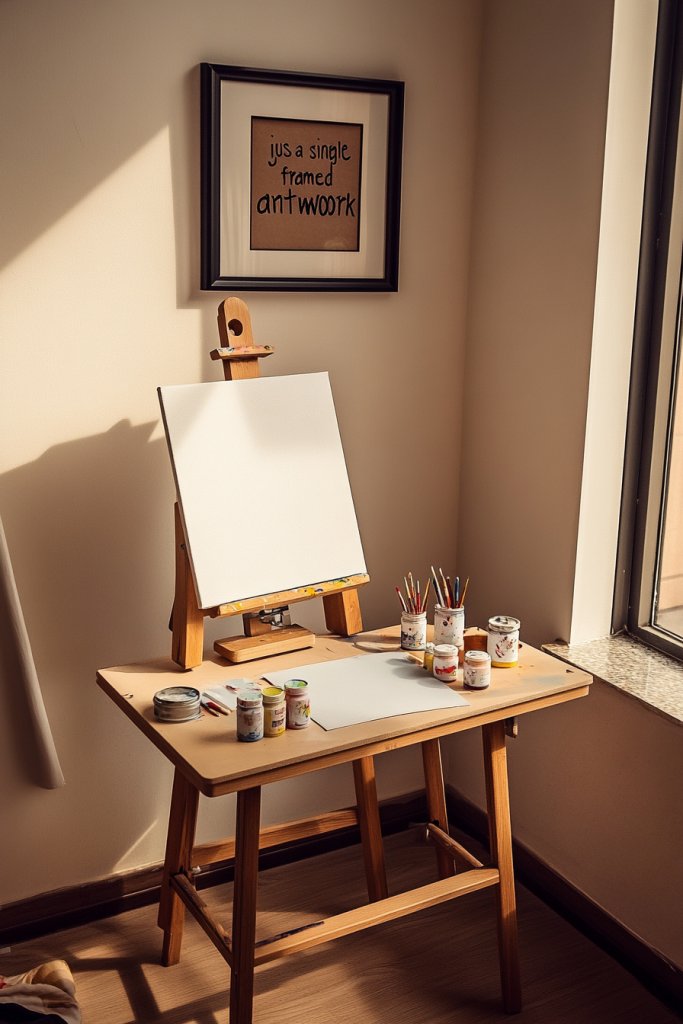
Kids are naturally creative, but finding a dedicated space to unleash their artistic side can be tricky. Store-bought art supplies are great, but the real magic happens when kids have a designated area to experiment freely. Parents want to encourage expression without the mess taking over the entire room. The secret is setting up a simple, inspiring art station.
Imagine a small corner with a sturdy easel or a tabletop workspace, decorated with colorful paints, brushes, and canvases. The area is filled with natural light, making colors pop and inspiring creativity. The walls are lined with inspiring sketches or doodles, and a few shelves hold supplies within easy reach. A small, washable mat or tablecloth catches drips, keeping the space tidy. The overall vibe is playful, inspiring, and totally inviting for a budding artist.
For smaller spaces, opt for wall-mounted storage or portable art caddies. Use themed decor like space, animals, or abstract patterns to boost inspiration. Incorporate different textures—like cork boards or fabric-covered pinboards—for displaying artwork or holding supplies. Change up accessories seasonally or with your child’s evolving interests for continuous freshness.
Set up a sturdy table or easel in a well-lit corner of the room. Use plastic or wooden containers for organizing paints, brushes, and other supplies—label them for easy access. Cover the surface with a washable mat or old sheet to catch splashes. Hang a corkboard or clip display for showcasing current projects. Regularly refresh supplies or introduce new mediums like clay or fabric for variety. Encourage your child to clean up after each session to develop good habits.
Let your kid choose their favorite colors or themes for the station. Add personalized touches like a name plaque or custom artwork on the walls. Incorporate a small gallery display area for their best work—this builds confidence. Keep a special box for their favorite projects or awards from art classes.
A dedicated art space nurtures their confidence and passion for creativity. It makes art feel like a special, valued activity—not just a messy pastime. Watching their skills grow over time is incredibly rewarding. Plus, it’s a fun way for the whole family to get involved in artistic adventures together.
6. Multi-Level Beds with Play Spaces Below
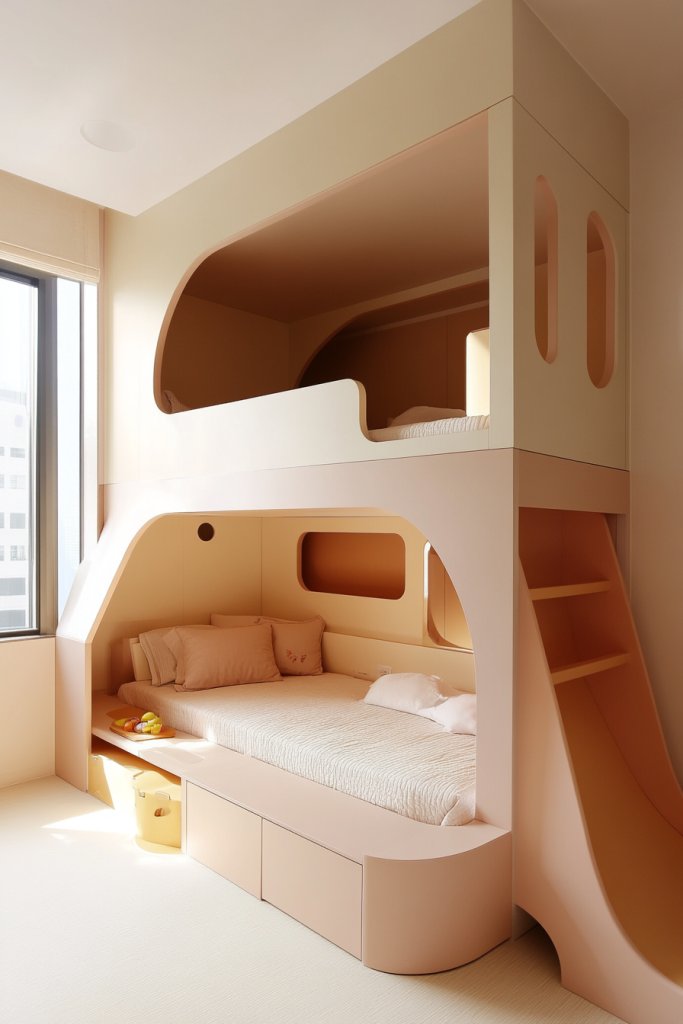
Room space is often a limiting factor, especially with siblings sharing. Conventional beds take up precious floor space, leaving less room for play or study. Parents want a clever solution that maximizes space and adds a fun element to the room. The idea is to combine sleeping and play areas into one dynamic setup.
Imagine a sturdy loft bed with a slide or a secret hideout underneath. The top bunk looks cozy with colorful bedding and a secure railing, while the space below is transformed into a mini fort, reading nook, or game zone. Bright, cheerful colors and soft textiles make the entire structure inviting. The design integrates seamlessly into the room, with enough clearance for imaginative adventures and safe play. The overall effect is a playful, space-efficient centerpiece that sparks joy.
Opt for different themes—pirates, space explorers, or jungle safaris—based on your child’s interests. The play zone underneath can include a small chalkboard wall, a tent, or a soft rug for comfort. For smaller rooms, choose compact designs with integrated storage or desks. Seasonal accessories like themed bedding or curtains can keep the area fresh and exciting.
Choose a sturdy, safe loft or bunk bed with guardrails and a reliable ladder. Measure ceiling height to ensure enough clearance for comfortable movement. Add a slide or climbing wall for extra fun—just make sure they’re securely installed. Decorate underneath with soft mats or cushions for a cozy play area. Incorporate storage drawers or shelves under the bed for toys and books. Regularly check safety features and structural integrity.
Allow your kids to pick themes or colors for the bed and play space. Add string lights or decorative banners (away from restricted items) to enhance the ambiance. Create custom decals or wall stickers for the area beneath to match their current obsession. Encourage them to decorate their own space with personal items to foster ownership.
Multi-level beds turn a boring bedroom into an adventure land, encouraging active play and independence. Kids love having a space that feels like their own mini world. It teaches them to be responsible for their environment and safety. Plus, it’s a smart way to make every inch of their room work for fun and rest.
7. Interactive Chalkboard or Whiteboard Walls
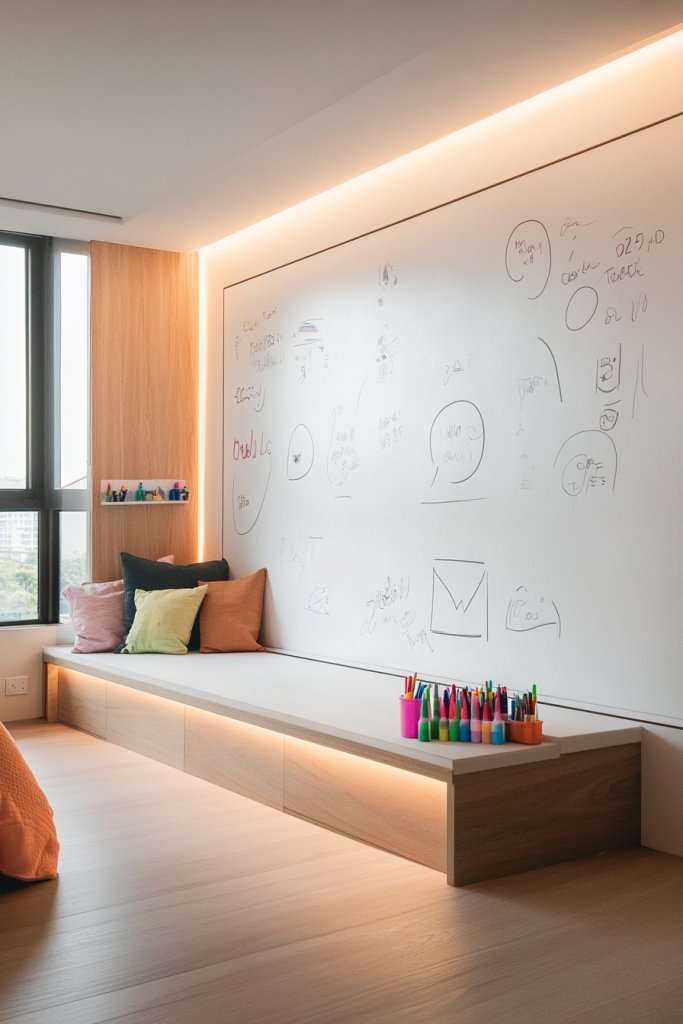
Kids often get bored quickly, especially when they have to sit still or stay quiet for too long. A plain wall offers no outlet for their endless ideas and doodles. Parents want a way to channel their energy into something creative that can also be educational. The goal is a fun, versatile surface that sparks spontaneous imagination.
Visualize a large section of wall painted with chalkboard or whiteboard paint, covering an entire wall or a big panel. Kids draw colorful scenes, practice spelling, or solve puzzles directly on the surface. The area is lively with sketches, notes, and doodles—each a reflection of their current interests. The textured surface invites tactile creativity, with chalk dust or marker ink adding to the sensory experience. The space becomes a dynamic canvas that evolves with their imagination.
Choose magnetic chalkboard paint for added functionality—kids can stick notes or magnets to their creations. Combine with cork boards or fabric panels for a multi-use wall. For smaller rooms, paint a single section behind a door or in a nook. Use colorful chalks or erasable markers to match their room decor and keep it playful. Seasonal changes can include themed doodle prompts or inspirational quotes.
Prepare the wall by cleaning and sanding to ensure a smooth surface. Apply the chalkboard or whiteboard paint in even coats with rollers or brushes—multiple layers may be needed. Allow adequate drying time between coats. Once dry, encourage your child to decorate and start drawing. Regularly clean the surface with appropriate cleaners to maintain a good drawing experience. Consider adding a nearby ledge or storage bin for chalks, markers, and erasers.
Have your child pick themes or designs to inspire their artwork. Add decorative borders or decals around the chalkboard for a finished look. Use different colors of chalk or markers for variety and excitement. Encourage them to create a rotating gallery of their favorite drawings or notes, which they can update anytime.
This interactive wall boosts confidence by giving kids ownership of their space. It turns everyday doodles into a source of pride and motivation. Plus, it keeps their minds active and engaged, fostering learning and self-expression. A chalkboard or whiteboard wall is a simple, cost-effective way to make the room lively and inspiring.
8. Under-Desk Creativity Zones with Craft Storage
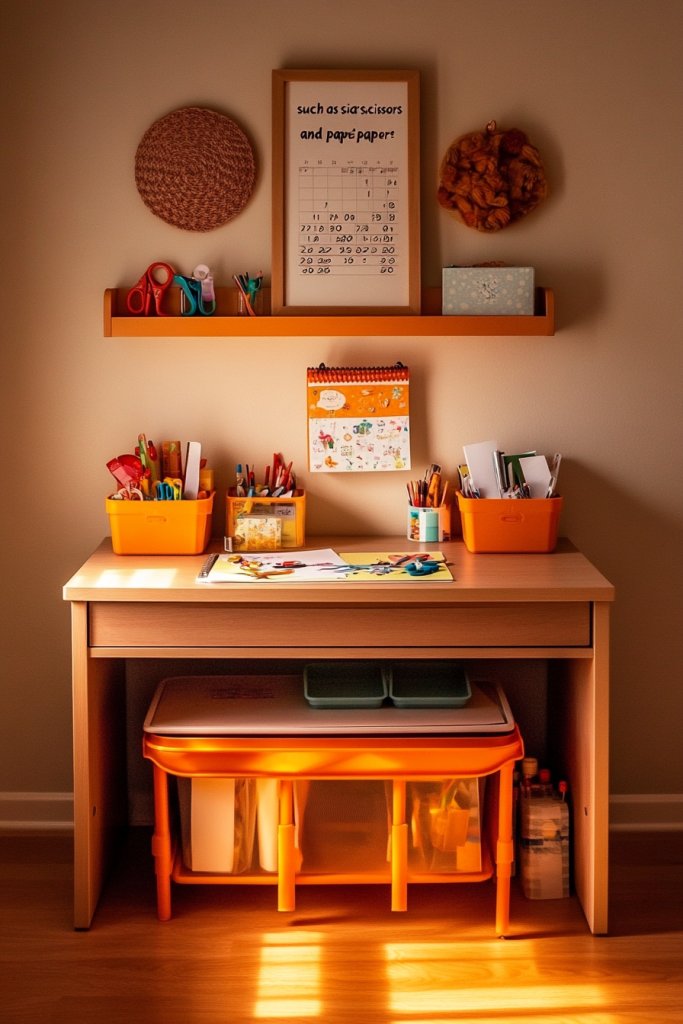
Kids often end up with art supplies scattered across the floor, making cleanup a nightmare. A dedicated spot for creative projects helps keep everything organized and accessible. Parents want a practical, space-efficient solution that encourages kids to craft independently. The challenge is designing a functional zone that’s both inspiring and easy to tidy.
Picture a compact desk tucked under a window or corner, with a pull-out drawer or open shelves filled with art supplies—colored pencils, paints, paper, and glue. The area is brightly lit, with a comfortable stool or chair that fits perfectly. Storage containers are labeled and within easy reach, while a small corkboard or magnetic strip above holds current projects or ideas. The entire space feels inviting—like a mini art studio just for your kid.
Use adjustable or modular storage to grow with your child’s needs. Incorporate a fold-down work surface for smaller rooms or shared spaces. Decorate with themed accessories—like superhero decals or floral patterns—to match their interests. Seasonal updates can include new storage bins or decorative touches that make the zone feel fresh.
Set up a sturdy, child-friendly desk with drawers or baskets for supplies. Use clear containers for easy identification and quick access. Install a small wall-mounted board or clip strip for displaying current artwork or ideas. Keep a tidy routine—encourage your kid to put things back after each session. Add a small trash bin to teach cleanup habits. Regularly rotate supplies to keep the zone exciting.
Let your child choose their favorite colors or themes for storage and decor. Add personalized labels or drawings to bins for a custom touch. Incorporate their artwork into the overall decor or create a mini gallery on the wall. Encourage them to organize their supplies and decorate their space with personal projects.
Having a dedicated creative zone fosters independence and pride in their work. It makes art time less chaotic and more rewarding. Kids learn to organize and care for their supplies, building responsibility. It’s a small space with a big impact—turning everyday crafting into a joyful, inspiring experience.
9. Eco-Friendly Natural Material Decor Elements
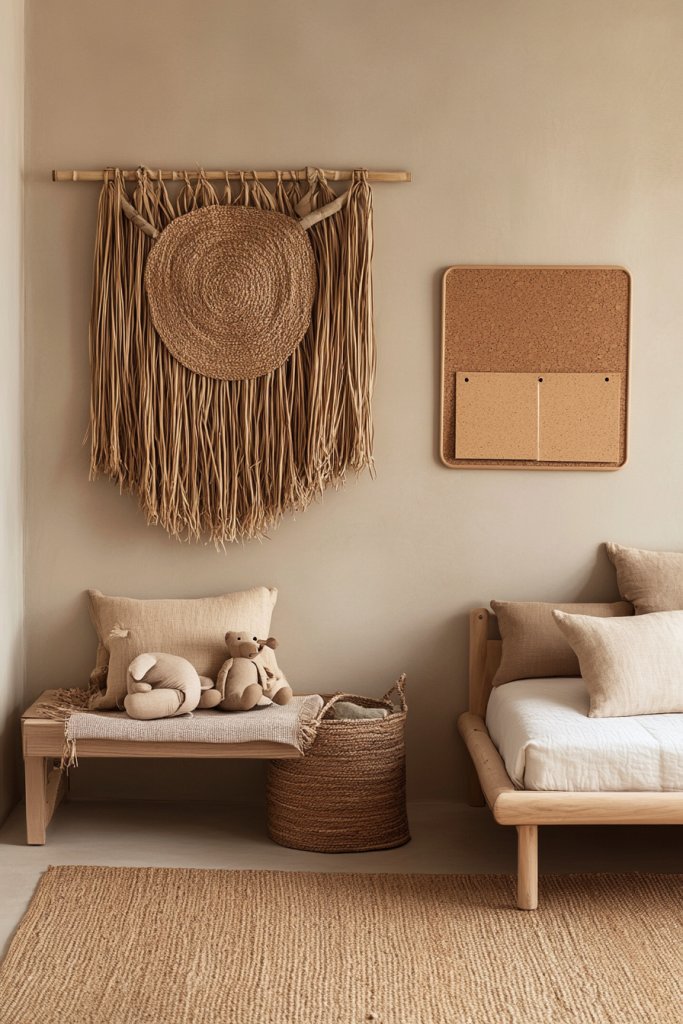
As awareness of sustainability grows, parents want eco-friendly decor options for their kids’ rooms. Conventional plastics and synthetic fabrics can feel out of place in a space meant for growth and learning. The challenge is creating a calming, natural environment that’s safe and nurturing. The solution lies in incorporating organic, sustainable materials into the decor.
Imagine a room accented with bamboo blinds, cork wall panels, and organic cotton textiles. Natural wood furniture with visible grain adds warmth and texture, while soft, earthy-toned rugs invite barefoot play. Small decor items, like woven baskets or handcrafted mobiles, add organic charm. The color palette draws from nature—beige, terracotta, moss green—creating a serene, grounding atmosphere. The overall look is simple yet rich in texture, fostering a sense of calm and mindfulness.
Combine reclaimed wood or bamboo furniture with plush, organic textiles for a cozy feel. Use biodegradable or natural fiber curtains, bedding, and stuffed animals. Seasonal decor can include wool throws or linen sheets, which are breathable and sustainable. For a modern twist, pair natural elements with minimalist design principles, avoiding clutter and excess.
Source decor items made from sustainable materials—look for certifications like FSC or GOTS. Incorporate furniture with visible natural finishes or untreated wood that ages beautifully. Use organic cotton or hemp textiles for bedding, curtains, and rugs. Avoid plastic toys and opt for handcrafted wooden or fabric toys instead. Regularly clean with eco-friendly products to maintain the natural vibe. Incorporate natural scents, like lavender sachets or beeswax candles, for sensory appeal.
Encourage kids to help select eco-friendly decor items or craft their own using natural materials. Incorporate handcrafted or fair-trade accessories for added uniqueness. Personalize with simple, natural decor like stamped wooden name plaques or woven wall hangings. Use biodegradable paint or dyes for any DIY projects or touch-ups.
Creating a natural, eco-friendly space teaches children to appreciate sustainability and mindful living. It’s a calming environment that supports focus and emotional well-being. Plus, they’ll develop responsibility for their environment from a young age. Living in harmony with nature starts at home, and their room can be a beautiful example.
10. Floating Shelves for Displaying Kid-Created Art
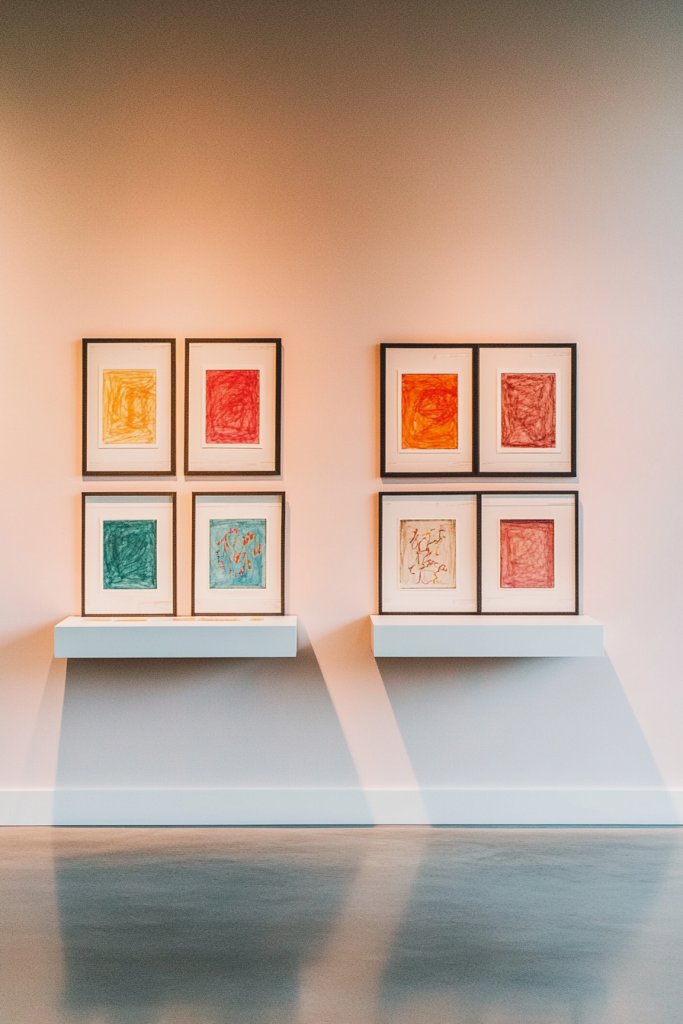
Kids love showing off their latest masterpieces, but cluttered surfaces make the room feel chaotic. Traditional frames or bulky shelving can make displays look cluttered or outdated. Parents want an easy, stylish way to celebrate their child’s creativity without sacrificing space or style. The goal is to create a dedicated, dynamic display zone that’s flexible and fun.
Picture sleek, minimalist floating shelves mounted at varying heights on a wall. These shelves hold a rotating collection of drawings, crafts, or small sculptures—each piece highlighted by the clean lines of the shelves. Brightly colored frames or clips add pops of color, making artwork stand out. The display feels lively and ever-changing, with new creations added weekly. The open design allows for easy updates, making the wall a living gallery of their progress and passions.
Use different shelf lengths and colors to match your child’s room decor or personality. Add small decorative items or themed figurines to complement the artwork. Incorporate magnetic strips or hooks for hanging three-dimensional crafts or jewelry. For rooms with limited wall space, place shelves above a desk or bed for maximum impact.
Select sturdy, lightweight floating shelves with hidden brackets for a clean look. Mount them at a height suitable for your child’s reach and comfort. Use small, colorful brackets or painted wood for a playful touch. Arrange artwork using clips, strings, or leaning frames, and rotate pieces regularly. Keep tools handy for easy adjustments or additions. Make sure shelves are securely anchored to prevent accidents.
Let your child decide what to display—perhaps their favorite themes or current projects. Incorporate themed or decorative clips and labels for a personalized touch. Add small LED clip lights or fairy lights (away from restricted items) to highlight special pieces. Encourage them to curate their gallery, which fosters pride and ownership.
A dedicated art display boosts their confidence and encourages ongoing creativity. It teaches them to value their work and celebrate progress. Plus, it adds a vibrant, personalized touch that makes the room feel truly theirs. Ready to turn blank walls into a showcase of talent and imagination?
11. Adjustable Lighting for Different Activities
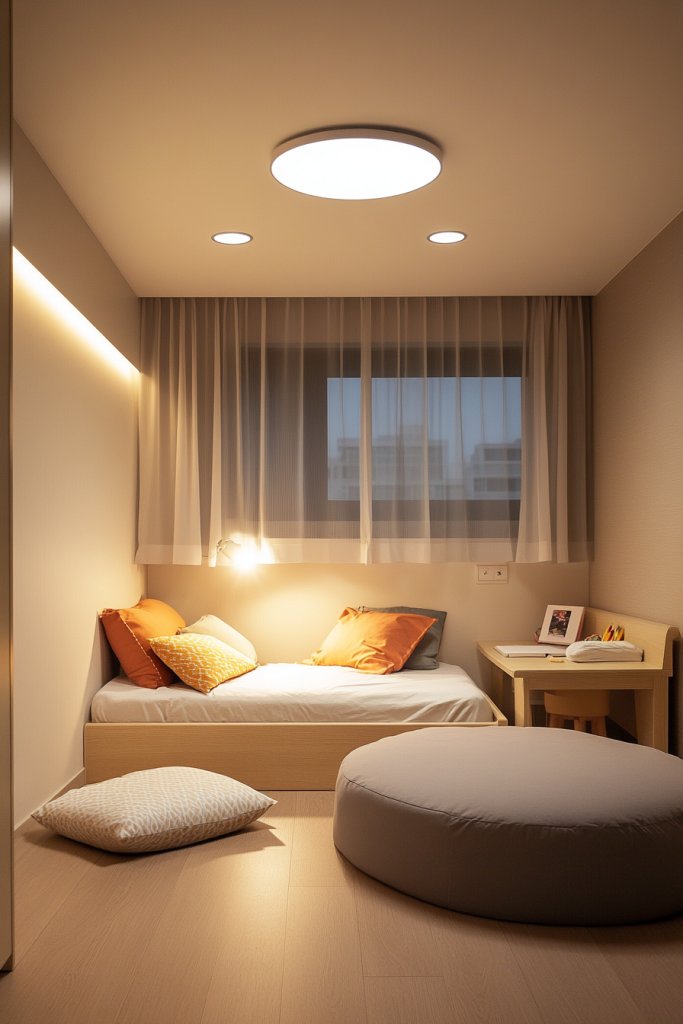
Lighting plays a crucial role in how a room feels and functions, especially for kids who need different atmospheres for studying, playing, or relaxing. Harsh overhead lights can feel overwhelming, while dim lighting might hinder homework. Parents want versatile lighting options that adapt seamlessly to various needs and moods.
Visualize a room with layered lighting—bright, adjustable task lights for homework, soft string or fairy lights for relaxing, and focused reading lamps. Dimmable fixtures allow easy control over brightness, creating the perfect environment at any time. The lighting setup is sleek, blending into the decor with minimal clutter. Warm hues flood the space during cozy evenings, while bright, cool lights energize active playtimes. The space feels dynamic, inviting, and perfectly suited for every activity.
Use smart bulbs or adjustable fixtures that can be controlled via remote or app for convenience. Incorporate wall sconces or clip-on lights that don’t take up desk or bedside space. Use string lights or LED strips for ambiance—these can be shaped into fun patterns or symbols. Seasonal considerations include switching to warmer bulbs during winter or brighter LEDs for summer.
Install dimmable overhead fixtures or add plug-in dimmer switches to existing lights. Use adjustable desk or clip-on lamps that can be directed precisely where needed. Position lights strategically around study areas and play zones, avoiding glare or shadows. Consider energy-efficient LEDs for longevity and cost savings. Regularly check fixtures and replace bulbs to maintain optimal lighting quality. Use smart controls to switch between modes easily.
Let your child pick their favorite light colors or themes—like star-shaped or cloud-shaped fixtures. Incorporate decorative lampshades or covers that match their room decor. Create different lighting ‘scenes’ for study, relaxation, or play, and teach your kid how to switch between them. Add string lights with themed covers for special occasions.
Proper lighting transforms a room into a versatile, cozy environment that supports all activities. It encourages independence, as kids can adjust their space to suit their mood or task. A well-lit room boosts focus and reduces eye strain, making every moment spent there more enjoyable. It’s a simple upgrade with a big impact on daily life.
12. Themed Bed Frames with Built-In Storage
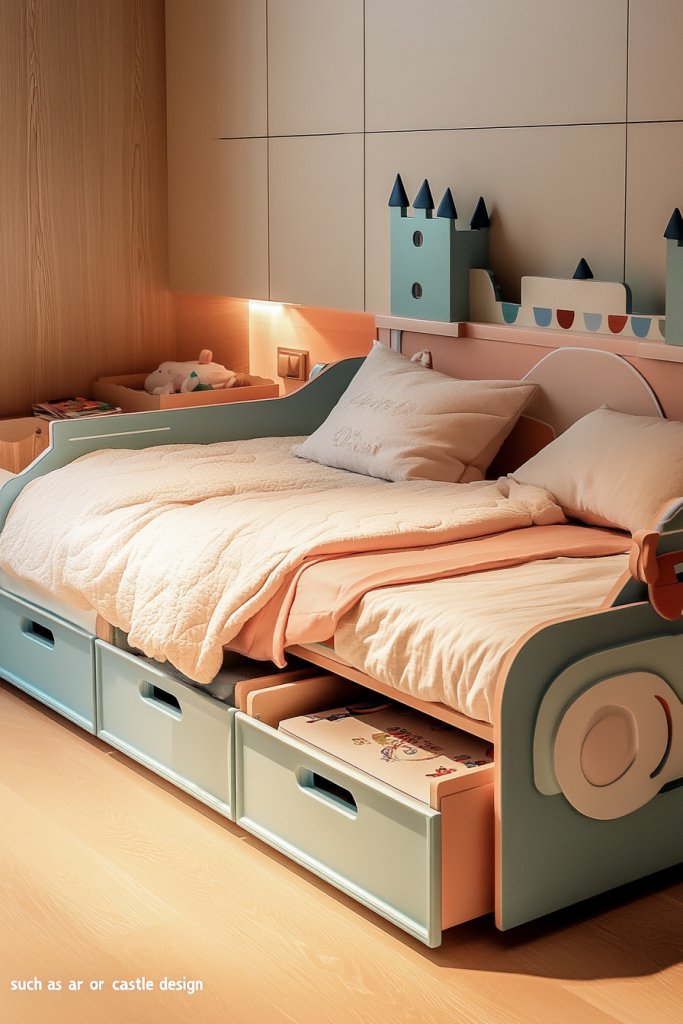
Standard beds are functional but lack personality and storage, leaving a bland or cluttered space. Kids love themed rooms that reflect their passions, but combining style with practicality often feels tricky. Parents want a bed that’s both fun and functional, helping reduce clutter while making bedtime exciting. The solution is a themed bed frame with integrated storage.
Imagine a bed designed as a spaceship, castle, or jungle hideout, with themed details like faux stone walls or rocket fins. The bed’s frame includes built-in drawers or shelves underneath, perfect for toys, clothes, or bedding. Bright colors and playful shapes make the bed a standout feature—an inviting retreat that doubles as a decor statement. The room feels cohesive, with decor matching the theme—think starry bedding or animal prints. The visual impact is playful, engaging, and organized.
Choose themes aligned with your child’s current interests—pirates, princesses, dinosaurs, or space explorers. Mix and match storage options: drawers, hidden compartments, or headboard shelves. For smaller rooms, opt for vertical storage or fold-away beds to conserve space. Seasonal or current interests can inspire new accessories or bedding to keep the theme lively.
Select a sturdy bed frame with the desired theme, ensuring safety features like guardrails. Measure the room’s dimensions and ceiling height for proper fit. Install storage drawers or shelves integrated into the frame—many models come pre-designed. Decorate with matching bedding, curtains, or decals that complement the theme. Regularly check the structural integrity, especially if kids climb or jump on the bed. Keep clutter organized in the built-in storage.
Let your child choose their favorite colors or customize the theme with personal touches—like adding their name or favorite characters. Incorporate themed accessories such as plush toys, wall decals, or bedding. Encourage your child to decorate their storage areas with drawings or labels, fostering ownership. Seasonal updates include new bedding or themed decor to keep the room fresh.
Themed beds turn bedtime into a fun adventure, making kids look forward to sleeping. They learn to take pride in their personal space, fostering independence. Plus, it consolidates decor and storage into one cohesive unit, reducing clutter and creating harmony. It’s a winning combo of style, function, and fun.
13. DIY Wall Art with Recycled Materials
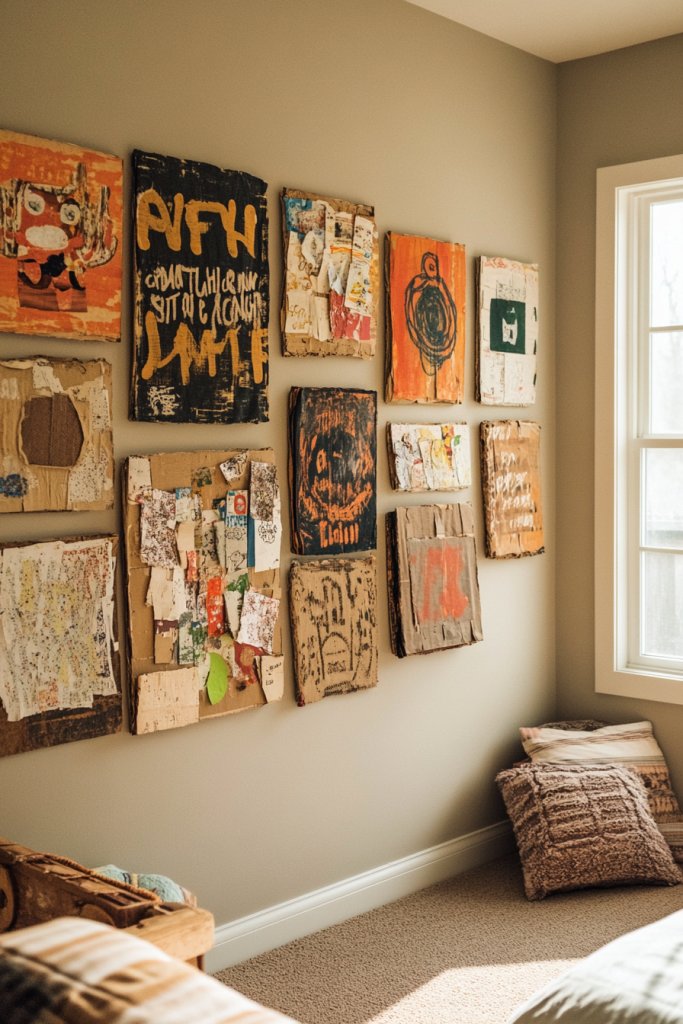
Kids love creating, but buying ready-made art can be expensive or uninspiring. Also, using store-bought decor often feels generic and lacks personal touch. Parents want a budget-friendly, eco-conscious way to decorate that also encourages their child’s creativity. The answer is DIY wall art crafted from recycled or found materials.
Picture colorful wall hangings made from cardboard, fabric scraps, or bottle caps arranged into mosaics or abstract patterns. These pieces hang proudly on the wall, showcasing your child’s imagination and resourcefulness. The textures are rich and varied—think layered paper, stitched fabric, or shiny caps—adding visual interest. The art feels uniquely personal, with a slightly rustic, handcrafted charm. The room becomes a gallery of creative recycling, inspiring both kids and adults.
Use themes like nature, abstract, or pop art, depending on your child’s taste. Incorporate natural elements like driftwood or pressed leaves (if available and safe). Mix different materials—wood, fabric, metal—to create layered, textured pieces. Seasonal or holiday-themed crafts can be swapped out to keep the decor fresh. The art can be framed or hung directly with colorful clips or strings.
Gather recyclable materials—think cardboard, fabric, bottle caps, or old magazines. Use non-toxic glue, paint, and simple tools like scissors or hot glue guns (with adult supervision). Design your pieces in advance or let your child experiment freely. Attach art pieces using hooks, clips, or adhesive strips—avoid damaging walls. Encourage a regular rotation to showcase new creations. Emphasize the importance of eco-friendly craft practices.
Help your child pick themes or color schemes for their artwork. Add personal touches like their name cutouts or favorite symbols. Frame some of their best pieces or create a dedicated art wall. Incorporate their art into DIY projects like lampshades or mobiles (without restricted items). Celebrate their effort with small awards or display areas.
Creating art from recycled materials shows kids how to be resourceful and environmentally conscious. It boosts their confidence by turning simple scraps into beautiful decor. They learn to value their creativity over store-bought options. Plus, it’s a fun, meaningful activity that can grow into a lifelong passion.
14. Playful Patterned Rugs for Dynamic Zones
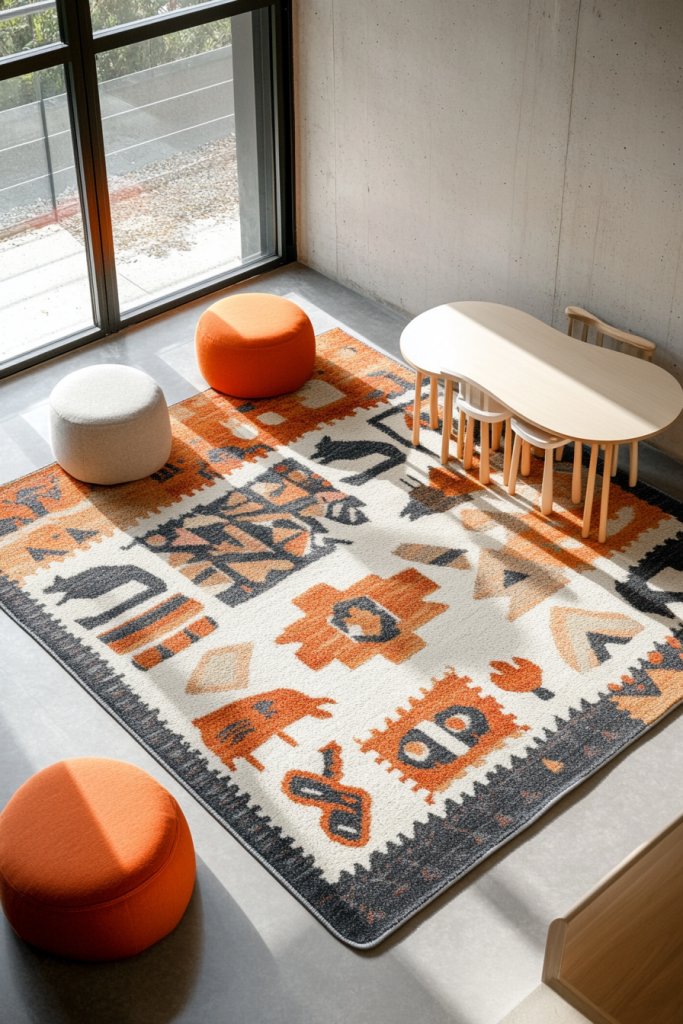
A plain floor can make a room feel dull and uninspiring, especially in a kid’s space meant for play and learning. A well-chosen rug can define zones, add comfort, and inject personality. Parents want colorful, playful rugs that withstand spills and wear while tying the room’s decor together. The challenge is finding patterns that are fun but also practical.
Imagine a vibrant, patterned rug with bold geometric shapes, whimsical animals, or swirling abstract designs. It covers a dedicated play area, making the space feel lively and inviting. Soft textures underfoot combine with bright colors to stimulate tactile exploration. The patterns can be large or small, depending on the room size, but always add a sense of movement and energy. The rug becomes a focal point, encouraging kids to gather, play, and imagine.
Choose rugs with themes matching your child’s interests—dinosaurs, princesses, or space. Mix patterns with solid colors for balance, or go all-in with a bold statement piece. For high-traffic areas, select durable, stain-resistant materials like nylon or polypropylene. Seasonal updates include layering rugs or changing accessories to keep the room fresh and fun.
Measure your space carefully to select an appropriately sized rug. Look for non-slip backing or add a non-slip pad underneath to prevent accidents. Opt for machine-washable fabrics for easy cleaning. Place the rug in key zones—play areas, reading corners, or under beds—to define these spaces visually. Regular vacuuming and prompt stain removal keep it looking vibrant.
Let your child pick their favorite colors or patterns, making the rug a reflection of their personality. Add themed cushions or plush toys on or around the rug for extra comfort. Create a layered look with smaller, contrasting rugs or mats for different zones within the room. Personal touches make the space uniquely theirs.
A playful rug transforms the room into a vibrant hub of activity. It encourages kids to engage actively in play and learning. Seeing their favorite patterns or characters daily reinforces their personality and interests. It’s an easy, affordable way to boost their mood and make every inch of their room feel alive.
15. Multi-Functional Furniture for Flexible Spaces
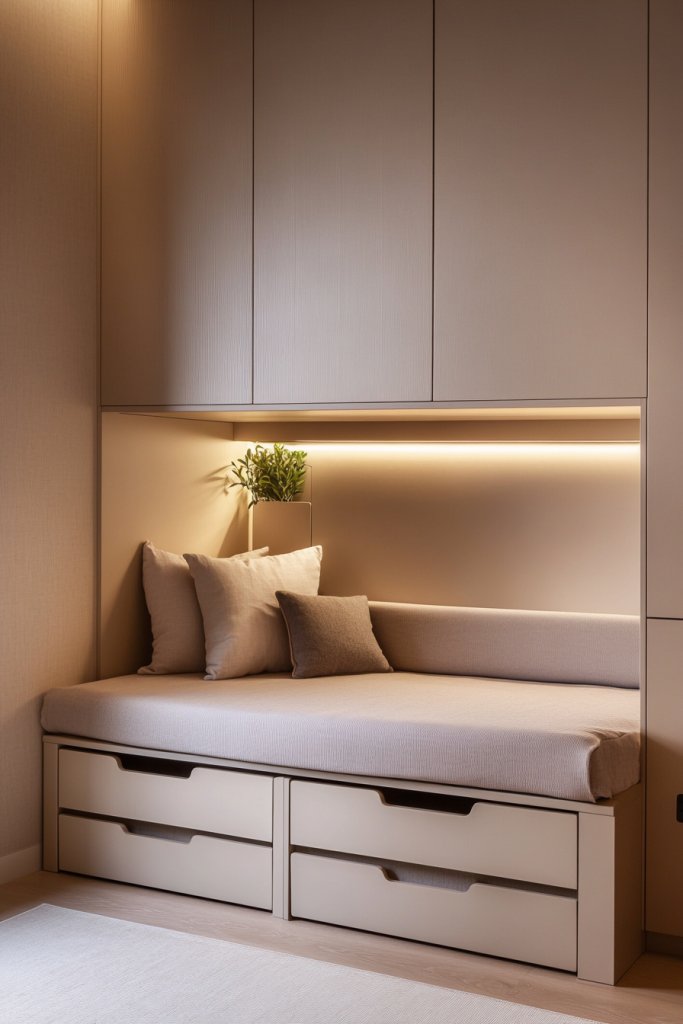
Limited space often forces parents to compromise on comfort or style in a kid’s room. Furniture that serves multiple purposes can solve this puzzle, making small rooms feel bigger and more efficient. Kids benefit from furniture that adapts as they grow, offering both comfort and practicality. The challenge is finding pieces that are versatile without sacrificing aesthetics.
Imagine a sleek bed that folds into a sofa during the day or a storage ottoman that doubles as a desk. Modular units can be rearranged easily to suit changing needs—like a study corner transforming into a sleep space. The designs are modern, with clean lines and neutral tones, allowing easy integration into various decor styles. Bright, cheerful accents keep the space lively. The overall room looks spacious, organized, and adaptable to every activity.
Select furniture with hidden storage, fold-out features, or extendable components—perfect for growing kids or multi-use rooms. Use neutral palettes with colorful accessories to customize the look. For shared rooms, choose furniture that divides into zones for each child. Seasonal or thematic accents, such as bedding or cushions, can update the vibe without major changes.
Prioritize quality, sturdy pieces that can withstand daily use. Measure your space precisely and choose furniture with multiple functions—think beds with drawers, desks that fold away, or benches with storage. Assemble according to manufacturer instructions, ensuring stability. Incorporate flexible layouts to maximize space, moving pieces around as needed. Regularly check for wear or damage, especially in high-traffic areas.
Let your child choose colors or themes for their furniture. Add decorative elements like themed cushions, throws, or decals to match their style. Create a dedicated zone for homework or reading within the furniture arrangement. Encourage them to help with reorganizing or redecorating to foster ownership.
Multi-functional furniture turns a small room into a versatile haven that evolves with your child’s needs. It teaches them flexibility and creative problem-solving. They learn to manage their space responsibly while enjoying a stylish, comfortable environment. It’s a smart investment that makes their room feel bigger and more fun.
16. Nature-Inspired Decor for Calm and Creativity
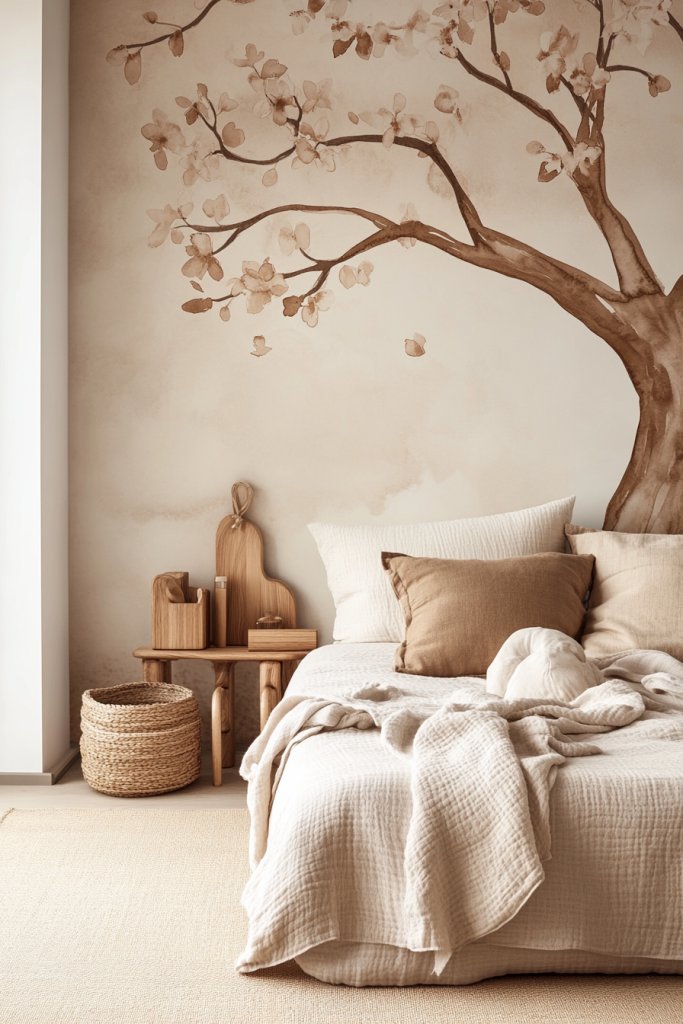
Kids thrive in environments that feel safe, calming, and inspiring. Overly cluttered or synthetic-looking rooms can hinder their ability to focus and dream. Parents want to create a space that nurtures their child’s curiosity and sense of wonder while promoting calmness. The key is incorporating natural elements that connect kids with the outdoors.
Visualize a room accented with wooden furniture, starry ceiling decals, and stone-textured wall panels. Soft textiles in earthy tones, like linen or wool, add tactile comfort. Decorative accents include woven baskets, driftwood sculptures, or organic cotton bedding. The room feels grounded yet lively, with a gentle, inviting aura. Natural light floods the space, highlighting textures and warm hues, creating a peaceful retreat for rest and imagination.
Mix natural materials with modern design—think sleek wooden beds paired with plush, wool throws. Use nature-inspired motifs in bedding or wall decals that are easy to change seasonally. Incorporate craft activities with natural materials like clay or pressed flowers to deepen the connection. For smaller spaces, focus on accent pieces like a wooden lamp or pebble-shaped cushions to keep the look light and airy.
Choose furniture made from sustainable, untreated wood or bamboo. Add textiles in neutral, calming colors—beige, moss green, soft browns. Decorate with natural accents like shells or stones, ensuring they’re clean and safe. Maximize natural light with sheer curtains and avoid artificial lighting overload. Incorporate eco-friendly cleaning products to maintain the natural vibe. Regularly update with seasonal natural decor—like pinecones or dried flowers.
Encourage your child to help select natural decor items or create DIY projects using organic materials. Add personal touches like a hand-painted wooden sign or a pressed flower frame. Use nature-inspired themes for bedding and accessories, and involve your child in arranging their space. Keep a small collection of natural treasures they find outside, integrating them into the decor.
A nature-inspired room teaches kids appreciation for the environment and mindfulness. It fosters a peaceful mind, boosting focus and emotional resilience. Kids grow up feeling connected to the outdoors, which can inspire lifelong eco-conscious habits. Their room becomes a tranquil sanctuary for both rest and creative exploration.
17. Personalization with DIY Name Signs and Art Displays

Kids love seeing their name in lights, or at least on their walls, because it gives them a sense of ownership and pride. Generic decor feels impersonal and dull, missing the chance to celebrate their uniqueness. Parents want a simple way to personalize their child’s space that’s meaningful and fun. The solution? DIY name signs and custom art displays.
Imagine a wall featuring a handmade wooden or fabric name sign crafted with colorful paints, stickers, or textured materials. Surrounding it are mini art displays—framed drawings, collages, or even their own photographs. The displays are arranged in a playful, balanced layout, making the space lively and personal. The signs and art showcase their personality—whether they love animals, space, or sports—and add warmth to the room. The overall effect is cozy, proud, and uniquely theirs.
Use different materials—wood, fabric, foam—for signs, depending on your craft skills and room style. Incorporate LED lights or glitter for extra flair (avoiding restricted items). Create themed art displays that change with seasons or interests—like sports, music, or nature. Add small shelves or clipboards to easily swap out art or display new creations over time.
Gather craft supplies: wood or foam letters, paints, stickers, and glue. For signs, paint or decorate the pieces as desired, then attach to the wall with removable hooks or strips. Frame favorite artworks using inexpensive frames or create a dedicated display panel. Arrange signs and art at eye level for easy viewing. Encourage your child to help with the design and placement for a personal touch. Regularly update displays to keep the room fresh.
Let your child choose colors, themes, or motifs for their signs and art. Add personalized touches like their favorite characters or hobbies. Incorporate their handwriting or doodles into the displays for authenticity. Use decorative borders, washi tapes, or stickers to enhance visual appeal. Celebrate their creations with small awards or special recognition.
Personalized decor reinforces their sense of identity and pride. It shows them that their interests and efforts matter, boosting confidence. Creating and updating these displays fosters a sense of accomplishment and responsibility. Their room becomes a curated space that reflects who they are—an inspiring, joyful environment for growth and imagination.
Conclusion
Explore the diverse range of kid bedroom ideas featured here, from colorful themes to clever organization tips, all aimed at fostering creativity and comfort. Whether you’re aiming for a whimsical fairy tale castle or a sleek, modern retreat, these ideas are easy to implement and customizable. Don’t hesitate to try these creative concepts in your own home—your child’s dream room is just an idea away. Start transforming their space today and watch their imagination soar!
Leave a Reply